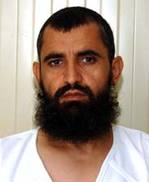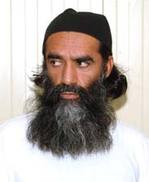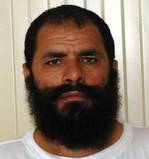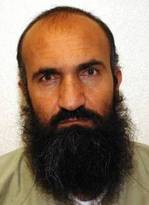The US government announced today that Sgt. Bowe Bergdahl, who was held by the Taliban since 2009, has been released. Bergdahl was exchanged for the top five Taliban commanders held at Guantanamo. The Taliban detainees are reportedly being transferred to Qatar, which helped broker the deal.
The Taliban has long sought freedom for the "Gitmo Five," all of whom are experienced jihadists and helped run the Taliban's operations in pre-9/11 Afghanistan. They served in various military and intelligence roles.
All five of the detainees were deemed "high" risks to the US and its allies by Joint Task Force Guantanamo (JTF-GTMO). Two of the five, according to files prepared at Guantanamo, have been wanted by the UN for war crimes.
One of them served as a key intermediary between the Iranian regime and the Taliban after 9/11. During meetings between these two former foes, the Iranians pledged to assist the Taliban in its war against the US.
The Obama administration has long sought to coax the Taliban into meaningful peace talks, which have thus far been fruitless. The Taliban has demanded that the "Gitmo Five" be released before those talks move forward.
A key goal of those talks is to get the Taliban to renounce al Qaeda, something Mullah Omar's group has declined to do. It is difficult to see how the prisoner swap helps to achieve that goal. All five of the now ex-Gitmo detainees were closely allied with al Qaeda prior to their detention. And Bergdahl was initially captured by members of the Haqqani Network, which remains one of al Qaeda's strongest allies to this day.
The Long War Journal has published extensive profiles of the five former Guantanamo detainees previously. See LWJ reports: Iran and the Taliban, allies against America; Afghan peace council reportedly seeks talks with Taliban commanders held at Gitmo; DC district court denies former Taliban governor's habeas petition; Taliban seek freedom for dangerous Guantanamo detainees; and Afghan Taliban announces new 'political office' in Qatar.
The profiles below, which are based on declassified and leaked documents, are culled from these previous accounts.
Abdul Haq Wasiq (Internment Serial Number 4), senior Taliban intelligence official
Abdul Haq Wasiq, a former Taliban intelligence official, "had direct access to Taliban and Hezb-e-Islami Gulbuddin (HIG) leadership," according to a leaked JTF-GTMO threat assessment. Wasiq "was central to the Taliban's efforts to form alliances with other Islamic fundamentalist groups to fight alongside the Taliban against US and Coalition forces after the 11 September 2001 attacks."
JTF-GTMO concluded that Wasiq "utilized his office to support al Qaeda and to assist Taliban personnel elude capture" in late 2001. Wasiq also "arranged for al Qaeda personnel to train Taliban intelligence staff in intelligence methods."
Al Qaeda's training of Taliban operatives, arranged by Wasiq, was reportedly conducted by Hamza Zubayr, a terrorist who was formerly an instructor at one of al Qaeda's most important training camps. Zubayr was killed during the same September 2002 raid that netted 9/11 facilitator Ramzi Binalshibh. The assistance from Zubayr was crucially important to the Taliban's intelligence efforts, according to the JTF-GTMO file, because many of the administrators in the Taliban Ministry of Intelligence "had no prior intelligence background."
Mullah Norullah Noori (ISN 6), senior Taliban military commander
Another leaked JTF-GTMO file described Noori as a "senior Taliban military commander" who was engaged in hostilities "against US and Coalition forces in late 2001." Noori is "wanted by the United Nations (UN) for possible war crimes including the murder of thousands of Shiite Muslims."
When the JTF-GTMO threat assessment for Noori was authored in February 2008, his brother was still active in the fight against the Coalition. Noori's "brother is a Taliban commander directing operations against US and Coalition forces in Zabul Province." Noori himself "remained a significant figure to Taliban supporters" even after his capture.
In addition to his ties to Mullah Omar and other senior Taliban leaders, Noori was "associated with...senior al Qaeda members and other extremist organizations."
Declassified memos authored at Guantanamo provide more details about Noori's al Qaeda ties. Noori "fought alongside al Qaeda as a Taliban military general, against the Northern Alliance" in September 1995. Noori also "hosted al Qaeda commanders" and "met a subordinate of Osama bin Laden to pass a message from the Taliban supreme leader" - that is, a message from Mullah Omar.
Mullah Mohammad Fazl (ISN 7), Taliban deputy minister of defense
Mullah Mohammad Fazl was one of the Taliban's most experienced commanders prior to his capture in November 2001. Like Noori, according to another leaked JTF-GTMO file, Fazl is "wanted by the UN for possible war crimes including the murder of thousands of Shiites." Fazl "was associated with terrorist groups currently opposing U.S. and Coalition forces including al Qaeda, Islamic Movement of Uzbekistan (IMU), Hezb-e-Islami Gulbuddin (HIG), and an Anti-Coalition Militia group known as Harakat-i-Inqilab-i-Islami."
Fazl had "operational associations with significant al Qaeda and other extremist personnel," according to JTF-GTMO. One of the high-ranking al Qaeda commanders Fazl long cooperated with was Abdel Hadi al Iraqi, who led Osama bin Laden's Arab 055 Brigade in the Taliban's Afghanistan. The 055 Brigade was bin Laden's chief fighting force and served alongside Taliban units.
Immediately "following the assassination of Northern Alliance commander Ahmad Shah Massoud in September 2001," al Iraqi explained to US officials, "the Northern Alliance was demoralized" and he met with Fazl to "coordinate an attack with the Taliban against the Northern Alliance."
Prior to his detention, Fazl "wielded considerable influence throughout the northern region of Afghanistan and his influence continued after his capture." Fazl's "name and capture have been used in recruiting campaigns by the Taliban."
"If released," JTF-GTMO warned in a February 2008 memo, Fazl "would likely rejoin the Taliban and establish ties with [Anti-Coalition Militia] elements participating in hostilities against U.S. and Coalition forces in Afghanistan."
Mullah Khairullah Khairkhwa (ISN 579), former governor of Herat province
Khairkhwa was one of Mullah Omar's closest confidantes prior to his capture. According to a JTF-GTMO file, Khairkhwa "was directly associated" with both Osama bin Laden and Mullah Omar. "Following the 11 September 2001 terrorist attacks," the leaked JTF-GTMO file reads, Khairkhwa "represented the Taliban during meetings with Iranian officials seeking to support hostilities against US and Coalition Forces." In June 2011, a DC district court denied Khairkhwa's petition for a writ of habeas corpus, based in large part on his admitted role in brokering the Taliban's post-9/11 deal with the Iranians. [See LWJ report, DC district court denies former Taliban governor's habeas petition.]
As the governor of Afghanistan's western Herat province, Khairkhwa and "his deputy were probably associated with a militant training camp in Herat operated by deceased al Qaeda commander (in Iraq) Abu Musab al Zarqawi."
In declassified memos prepared at Guantanamo, US officials alleged that Khairkhwa became a major drug trafficker as well. Khairkhwa reportedly built three walled compounds that he used to manage his opium trade. And he allegedly oversaw one of Osama bin Laden's training facilities in Herat, too. One US government memo noted that only Khairkhwa or bin Laden himself "could authorize entrance" to the facility, which was one of bin Laden's "most important bases" and "conducted terrorist training two times per week."
Mohammad Nabi Omari (ISN 832), senior Taliban leader who served multiple roles
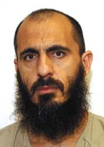
|
In a leaked memo dated Jan. 23, 2008, JTF-GTMO analysts recommended that Nabi be held in "continued detention" by the Defense Department. Nabi "was a senior Taliban official who served in multiple leadership roles," according to JTF-GTMO. Nabi "had strong operational ties to Anti-Coalition Militia (ACM) groups including al Qaeda, the Taliban, the Haqqani Network, and the Hezb-e-Islami Gulbuddin (HIG), some of whom remain active in ACM activities."
Intelligence reports cited by JTF-GTMO indicate that Nabi was a "member of a joint al Qaeda/Taliban ACM cell in Khowst and was involved in attacks against US and Coalition forces." Nabi also "maintained weapons caches and facilitated the smuggling of fighters and weapons."
Prior to the Sept. 11, 2001 terrorist attacks, Nabi worked for the Taliban's border security and in this capacity had "access to senior Taliban commander and leader of the Haqqani Network, Jalaluddin Haqqani." Haqqani was the Taliban Minister of Frontiers and Borders at the time and this is what gave Nabi the opportunity to become Haqqani's "close associate," according to JTF-GTMO.
One "sensitive contact" told authorities that Nabi was one of "three former Taliban commanders loyal to Haqqani." The other two are Nabi's brother-in-law, Malim Jan, and Gul Majid. The three worked under still another Taliban commander, Zakim Khan.
Malim Jan was nicknamed the "Butcher of Khowst" for his reported role in murdering 300 people there. Jan was a sub-commander under Haqqani and the head of a "Secret Police" unit.
Intelligence reports cited by JTF-GTMO indicate that Malim Jan, Gul Majid, and Zakim Khan were all still active in the insurgency in Afghanistan as of late 2007.
A "sensitive contact" told authorities that Nabi participated in a Jan. 26, 2002 "planning session to identify a new Governor of Khowst and to propose a list of members for the Khowst City Shura Council loyal to Haqqani." Several other high-level Taliban and Haqqani officials attended the meeting. One of them "directed the group to reconvene after members discussed names with al Qaeda members in their provinces." The leaked JTF-GTMO memo notes: "The plan was to have all personnel identified and vetted to prepare for future al Qaeda control of the area under Jalaluddin Haqqani."
Beginning in February 2002, according to another intelligence report cited by JTF-GTMO, Nabi and "three al Qaeda affiliated individuals held weekly meetings to discuss ACM plans and to coordinate Haqqani loyalists."
Then, in July 2002, an "Afghan government employee" reported that Nabi had joined "a new Khowst province ACM cell comprised of Taliban and al Qaeda commanders who had operated independently in the past." The list of cell members provided by this source included not only Taliban and al Qaeda leaders, but also individuals affiliated with the HIG and the Haqqani Network.
The JTF-GTMO file includes an intriguing detail about one member of Nabi's cell - a Haqqani money courier named Malik Khan. "Ayman al Zawahiri, the number two leader of al Qaeda" at the time, and now al Qaeda's emir, "has stayed at Khan's compound located outside Miram Shah," Pakistan.
In August 2002, Nabi reportedly helped two al Qaeda operatives smuggle "an unknown number of missiles along the highway between Jalalabad and Peshawar," Pakistan. The missiles were smuggled in pieces, with the intent of rebuilding them for attacks near the Jalalabad airport. On Aug. 28, 2002, JTF-GTMO analysts noted, "two Americans were killed during attacks against the Khowst, Gardez, and Jalalabad airports."
Nabi was captured in September 2002, detained at Bagram, and then transferred to Guantanamo. It was the end, temporarily at least, to a career that started in the 1980s when Nabi first fought as a mujahideen against the Soviets.
